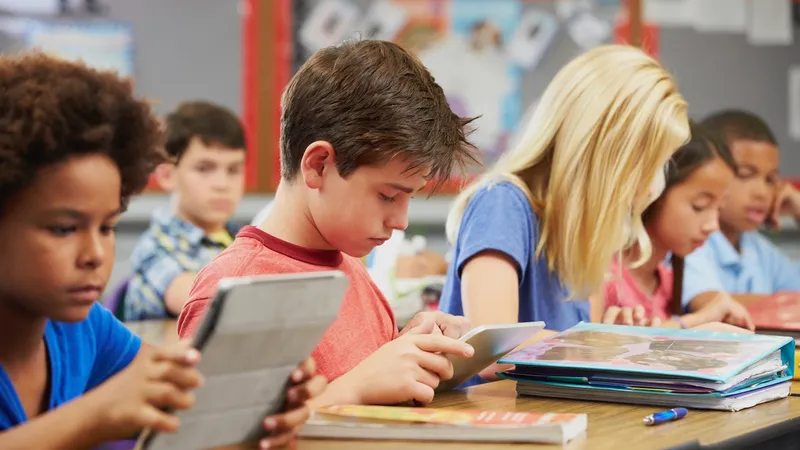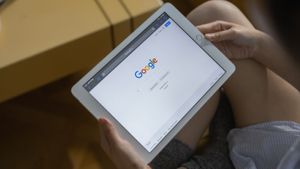In schools around the globe, the traditional classroom is evolving to take advantage of the new digital tools available to meet the needs of today’s tech-savvy students.
Read on to learn more about how digital technology in the classroom enhances the learning experience, encourages student engagement and empowers educators.
What is a digital classroom?
The digital classroom incorporates electronic devices and software into the learning environment.
Key elements of a digital classroom include:
- Devices: provide computers, laptops, tablets or smartphones to access digital resources, participate in interactive activities and complete assignments.
- Internet connectivity: allow online access to materials, collaboration and virtual interaction.
- Educational software and apps: create digital lessons, activities and assessments.
- Digital content: make educational materials available digitally.
- Collaboration and communication tools: enable seamless communications and interactions with online platforms and applications.
These tools can expand the potential for collaboration, extend access to resources and enable continued work outside of the physical classroom space.
Typical uses of digital tools in the classroom include teachers creating and sharing lessons via iPads, students completing assignments on shared or one-to-one devices and off-site access of resources and communication via internet connection.
Benefits of a digital classroom
The digital classroom transforms the learning experience for students by offering:
- Enhanced engagement and interactivity
- Personalized learning tailored for individual needs and abilities
- Expansive access to digital resources and self-directed learning
- Time and location flexibility, enabling students to learn at their own pace
- Opportunities for global collaboration and exposure to diverse perspectives
- Real-time feedback and assessment
To learn more about how this works in practice, read about how Apple and Jamf empowered students in Taiwan with world-class digital classrooms.
Challenges of a digital classroom
The digital classroom offers many advantages for students but there can be obstacles to successful implementation. Let’s discuss some common concerns.
Technology access
Not all students have the same access to technology, whether its available devices or internet access. Achieving digital equity can be difficult, especially for schools with limited budgets. If students are able to take home their devices, tablets like the iPad that use cellular data help alleviate this gap. Students who don’t have internet at home are able to do their school work wherever they are.
Time spent using technology
The Organisation for Economic Co-operation and Development (OECD) analyzed the impact of the COVID-19 pandemic on nearly 700,000 students over 81 countries. This data came from the results from administering the Programme for International Student Assessment (PISA) test.
The PISA test found a decline in performance related to overuse of technology. While moderate technology use is associated with higher performance, too much technology can distract instead of support learning. After a pandemic that shut down schools for months — or years — and forced students to learn on devices at all times, these effects are especially consequential.
OECD found that on average, students who spend up to one hour a day on digital devices for leisure scored 49 points higher in math compared to those who spent between five and seven hours per day. And students who reported they were distracted by other students using digital devices scored 15 points lower — equivalent to three-quarters of a year of education — in PISA math tests than those who didn’t experience this.
So performance declines when students are distracted by technology, whether they are using it themselves or are distracted by other students’ use. This is further complicated taking into account that 45% of students reported feeling nervous or anxious if their phones are not near them.
This means technology use needs to be efficient to be effective. There’s not one right way to achieve this, but generally it requires adequate tools with the right features and adequate training so teachers know how to get the most out of these tools.
Digital literacy
While the importance of providing equivalent technology for every user is crucial for reaching every learner’s potential, effective teacher training is also important. While students are learning how to be good digital citizens in class, teachers are also learning how to use evolving technology effectively.
One of the advantages of using Apple devices such as iPads is the abundance of free training offered for educators: part of the initial device purchase investment includes free training from Apple Education Community, Jamf Educator and Apple Professional Learning. In a later section, we’ll talk through some tools that can be used in the classroom and beyond to foster a healthy relationship with technology.
User privacy
And no less important: because this technology provides access to internet exploration, it requires a plan to keep students safe online. Tools like Jamf Teacher enhance the standard approach to content filtering by offering classroom-level controls, including providing specific web links to encourage exploration in a safe environment of specifically-allowed sites.
Students need privacy, but it can be difficult to balance this with safety. Administrators may receive external pressure to violate student privacy for the sake of “safety.” Realistically, responding to these pressures can actually have the opposite effect. Schools should choose tools that respect student privacy but have measures in place to prevent them from accessing dangerous parts of the internet.
Related reading: Technology in Schools: Keeping Students Safe Without Surveillance
The role of teachers in a digital classroom
In the "traditional classroom," a teacher’s role has been to provide content for learners and to help them understand context and application. But in the digital classroom, technology gives educators an opportunity to become more of a guide — to encourage independent thought and discovery that can lead to a deeper understanding of what the content means for each individual learner.
This is not to say that technology should totally replace a teacher. In the same PISA report mentioned earlier, OECD found that students’ math scores were 15 points higher on average when students had good access to teachers’ support. These students expressed more confidence than their peers to learn by themselves, even remotely.
Technology offers opportunities to express an understanding of the content in new ways, from video to audio or other imagery. As educators use technology to encourage self-directed learning, students are empowered to take more responsibility for their learning while having educators there to support their journey.
Beyond the traditional classroom, technology also provides opportunities to offer new learning spaces, meeting students’ individual needs for where and when they learn best. It’s essential for educators to have access to classroom management tools to empower students to use devices in and outside of the classroom.
Training and support for educators
For classrooms to use technology successfully and evolve to a digital model, schools should also plan how to support and train their educators.
Teachers may need to not only learn new skills such as tech proficiency and online moderation but also how technology provides new ways to share content, assess understanding and promote new thinking.
Digital classroom tools
Technology that is effectively used in modern classrooms includes:
Apple devices and software
Apple empowers student and educator success with powerful, intuitive tools that encourage creativity: including iPad, Mac and Apple TV devices.
As Apple devices have a lower long-term cost of ownership with higher resale value when compared with others, schools around the world are offering iPads to students. When both teachers and students use the same devices, it supports good classroom management and a shared understanding of the device's potential.
Designed for iPads and Macs, Apple Classroom gives teachers the ability to engage with their students, including those in the classroom and at home. Apple Classroom works with Apple School Manager to make it easy to assign devices to students and enroll them into classes.
Google Classroom
Google Classroom is an all-in-one tool enabling educators and students to engage together in lessons and coursework. Google Classroom can be learned in minutes; it helps educators manage their instruction and grade more efficiently. It features seamless integrations with other Google Workspace for Education tools like Drive, Calendar and Meet as well as popular third-party EdTech tools. Google Classroom gives educators streamlined ways to create enriching student experiences that make each lesson more personal.
Jamf School
Behind every effective technology deployment is a system that makes management and security work. Jamf School is a mobile device management (MDM) system for efficient classroom management enabling:
- Set up and organization of classes
- Connection with other teachers
- Communication with students
- Configuration for specific or shared users
- Assignment of specific apps as well as content to devices
Jamf School enables teachers to set up specific content for the correct classes at the right times, which makes it possible to offer age- and subject-appropriate content when and where it is needed. The end result: teachers can focus on using the devices, not how to set them up.
The Jamf Teacher app — included with Jamf School elevates classroom management with Apple Classroom. With this powerful combination, educators are empowered to provide simple and quick access to the resources that allow this type of learning while also monitoring student progress and support from a distance.
Jamf Safe Internet
Jamf Safe Internet provides educators piece of mind for students working online. When students search online, educators can trust that learners are protected from accessing inappropriate content. Filtering tools are simple to set up, with options for predefined settings including not only gaming, gambling and adult search but also additional customization for needs based on the age or stage of the learner.
Jamf Safe Internet also goes beyond content filtering and into threat prevention. It protects users and networks from the risks of phishing attacks, malware and ransomware — dangers that can cause issues with wider implications for institutions beyond the classroom.
The future of digital classrooms
The pandemic taught us that learning doesn’t have to be restricted by space and time. As the “traditional classroom” continues to evolve with increased investment in education technology, what can we expect future learning to look like?
We are seeing new schools that further blur the line between education and work. These innovators don’t simply replicate workplaces but also use technology in ways that enhance collaboration beyond borders. Learners can engage with experts from around the world and showcase learning that meets industry needs. In many cases, they can even inspire new thinking in the world around them.
When students receive the right tools and have the right support, they can be real change-makers in the years to come.
Make the most of the digital revolution with Jamf.
Jamf School helps schools deliver a secure, active learning environment to everyone with iPad, Mac and Apple TV devices.
by Category:
Have market trends, Apple updates and Jamf news delivered directly to your inbox.
To learn more about how we collect, use, disclose, transfer, and store your information, please visit our Privacy Policy.



